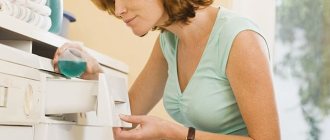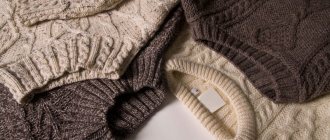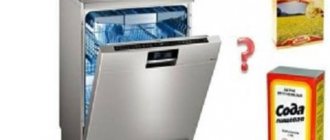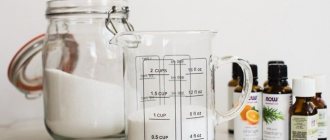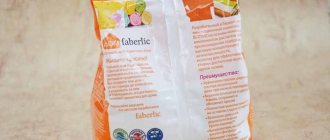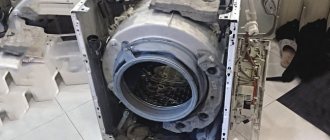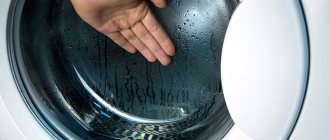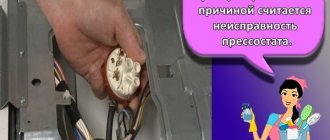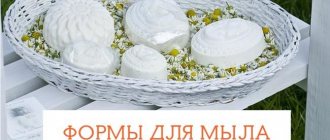Washing powder is an indispensable helper for the home. Today, housewives can no longer imagine how they could do laundry without it. They buy different types of powders, bleaches, conditioners, and cannot do without Calgon and other products. However, most of them rarely think about the threat posed by synthetic substances that are part of household chemicals. Although recently more and more women are trying to make washing powder with their own hands for use in automatic washing machines, it is important that it has high cleaning properties and is safe.
Which is better to choose: liquid, solid, powder?
The action of soap is based on the fact that the fatty acids contained in its composition react with dirt and wash it out of the fabric fibers with the help of foam. Therefore, the more fatty acids in the bar, the more effective its action.
Depending on the percentage of fatty acids, the industry produces several types of solid soap:
- Category 1, contains 70.5 – 72% fatty acids;
- category 2, consisting of 65-69% FA;
- Category 3, contains up to 64% of components.
Depending on the degree of concentration of fatty acids, the color of the bar changes. The more there are, the darker the piece.
Nowadays you can find laundry soap of different consistencies on sale:
- bar,
- liquid,
- powdery.
Soap powder is a crushed bar version. Soap is no different from bar soap, only crushed into crumbs. It is convenient to pour it into the drum or powder tray in the washing machine.
As for liquid soap, the situation is different. It is, of course, convenient to use for machine washing. As for the composition of this product, it has nothing in common with traditional soap.
If you read its composition indicated on the label, you can find surfactants, fragrances and other chemical components in it. Liquid soap has nothing in common with laundry soap.
The technology for the production of laundry soap and the substances included in its composition do not allow it to be produced in liquid form.
Necessary Precautions
Self-created washing powder must be hypoallergenic - this is why most housewives make it. However, the “production” process can be inconvenient. When mixed, tiny particles of ingredients (for example, soda) can enter the respiratory tract, causing a sore throat, tracheal irritation, and bronchospasm. To avoid this, it is necessary to cover your mouth and nose with a medical mask while working.
The negative consequences of using vinegar can be even stronger - even causing a chemical burn. When working with acids (in particular, when they are combined with alkaline components), you must protect yourself with a respirator. Medical gloves must be used. It is also advisable to cover your eyes with special glasses that fit tightly to the skin of your face.
Benefits of homemade soda composition
There are many benefits of using this soap composition:
- This product is highly effective in combating various contaminants, including coffee, blood, juices and mold.
- Suitable for all types of fabric, regardless of color and structure.
- Can be used both for hand washing and in automatic washing machines.
- Suitable for washing children's clothes from the first days of a child's life.
- Does not cause allergic reactions on the skin after hand washing, at the moment of contact with washed laundry.
- There are no deodorizing substances in the composition, the smell is not very pronounced and corresponds to the constituent components. The laundry does not have any foreign odors after drying.
- The product rinses out perfectly and does not require additional treatments.
- The gel makes laundry soft and fresh.
- The product is completely natural, as it is made from ingredients of natural origin.
A gel-like product made from soda ash and laundry soap is universal. It can be used not only for washing, but also as a cleaning and detergent, which is widely used in everyday life.
Additionally
At the beginning of the 20th century, in our villages they used ordinary clay to wash their clothes and also wash their faces.
Pottery clays remove greasy stains quite well (but not red ones!!! - they contain a lot of iron).
To make an ecological washing powder, you need to take a chestnut, peel the brown peel, dry the inner white core and grind it into flour. That's it, the powder is ready. Throw the powder into lukewarm water, stir and soak the laundry (6-12 hours).
Reminiscent of washing with natural laundry soap. Anyone who has washed with soap knows what it smells like. But the solution made from chestnuts has a barely perceptible pleasant smell. Plus, the skin on your hands feels just great. You can also wash it with horse chestnut (powder) - it has a pleasant smell, it foams a little, but it doesn’t remove the shine.
For washing clothes: rubbed chestnut fruits, wood ash for cotton and linen linen, soapwort (root powder), mustard powder, arleka fern root, red elderberry fruits (including for removing stains) and more.
To wash linen or knitted woolen fabrics, you can use an infusion of soap root (saponin). Infuse 50 g of soap root in 10 liters of hot (70 C) water for 24 hours, boil the infusion for 1 hour, cool and filter through a cloth. The infusion is diluted with water 2-3 times and the items are washed for 30-40 minutes.
To remove grease and remove stains when washing and washing hands, use the roots of the clove plant - white dawn, or lychnis alba.
Arguments about washing with soap in a washing machine
On many forums you can read a furious statement that it is strictly forbidden to use a laundry soap product for washing in a car, because you can simply destroy the parts and the heating element. It sticks to clothes, the walls of the centrifuge, is not completely washed out of the powder compartment, etc. It is not necessary to argue with such a statement; it is enough to simply open studies on this topic and familiarize yourself with them.
Data 1
Laundry soap does not foam much and is therefore suitable for washing in an automatic washing machine. And if you have soft water in your region, it’s generally ideal. The product leaves a trace after use inside the drum, and is not completely washed out of the washing powder compartment only when the water is hard and the soap alkali interacts with salts. If you prefer this product and have hard water, you can empty the machine once a week by pouring lemon juice or vinegar inside, which will remove all unwanted marks.
Given 2
People talk about the terrible smell of soap. But in fact, this statement has long since sunk into oblivion.
Modern manufacturers have long taken this drawback into account and removed the legendary smell, making the soap almost odorless. What smells usually contains a substance called soapstock, which gives the soap its aroma, as well as its darker color.
Washing with laundry soap in an automatic washing machine can bring incredible pleasure because it will remove all the dirt that washing powder simply cannot remove. The only advantages of the powder are a pleasant aroma and reduced foaming. But as we said above, the laundry soap product also does not have increased foaming, due to its total naturalness. And to remove the smell of soap, it is enough to use some fragrant, high-quality baby soap in a mix with it, or, when preparing a jelly solution for washing, add essential oils.
Given 3
Liquid laundry soap is a new product on the household chemicals market. It is the same as regular one in composition. Therefore, due to its good solubility, it is better suited for machine washing. The problem is solved and there is no need to worry about rubbing and preparing solutions.
In fact, there is some truth to the above statements. Liquid laundry soap for an automatic washing machine is better in terms of ease of use.
But if you take a closer look at the composition, you can find the notorious surfactants (toxic substances). They are what make the soap liquid - without them, laundry soap, due to its structure, cannot be liquid in any way.
Cleaning the base of the iron from carbon deposits
- Ingredients: laundry soap.
- Step-by-step instructions: turn on the iron to medium temperature, wait for it to heat up and unplug it. Lubricate the hot soleplate of the iron generously with laundry soap in places where burn marks accumulate; the soap will melt and form a crust at the site of application. Leave the iron to cool. Then rinse off the soap with a damp sponge or napkin; most of the carbon deposits will also be washed away. For final cleaning, heat the iron and iron a stiff matting-type fabric, placing the fabric on the edge of the ironing board and moving the iron at an angle.
Chemical composition of detergent
First, you need to understand what is included in both types of laundry soap, what are its advantages and how much liquid soap corresponds to the composition of regular soap.
Laundry soap is primarily sodium salt and residues of fatty acids, oleic or linolenic. Due to this and the absence of petroleum products or other chemicals in its composition, laundry soap is considered the most natural and biologically pure. It is classified according to the percentage of fatty acids, and according to this criterion it is divided into three categories:
- The first category contains 72% fatty acids - one of the most common and popular;
- The second category contains 70% acids;
- The third contains 65% acids.
The third category also often contains rosin
This substance promotes the formation of foam and good dissolution in cold water, which is important for laundry soap. Also, soapstock can be added to it
This product, derived from a solution of fats and oils purified by lye, makes the soap harder and harder. This prolongs the shelf life, but can make it smell bad or very dark if the substance is not of good quality.
At least this is how laundry soap was in Soviet times. Now synthetic acids or fatty acids with a safety certificate according to GOST are also added to its composition - instead of natural fatty acids. Foreign soap, in turn, is more natural - it contains palm and coconut oils, rosin, and sodium silicate. This soap foams better and does not stick.
Store-bought liquid laundry soap resembles Soviet standards for making laundry soap even less. Manufacturers claim that there is only one composition, but the label clearly mentions the toxic surfactants it contains, called surfactants. Rather, it is a kind of gel for washing and washing dishes, rather than a liquid analogue of laundry soap.
On the other hand, more “aggressive” chemical additives increase the cleansing qualities of liquid soap. It is also not subject to drying out, since it is made from potassium salts, and does not have the unpleasant odor characteristic of its conventional counterpart. Store-bought liquid soap is very gentle and easy to lather, washes well and removes stains.
It is also worth noting foreign analogues of liquid laundry soap. For example, the French product “EcoDoo”, unlike its Russian counterparts, is made on the basis of olive and linseed oil, as well as lavender and caramel. It does not contain petroleum products or preservatives, although it costs much more.
Some housewives prefer to use homemade liquid soap, the recipes for which we will discuss below.
Features of manual and machine processing
There are some features and differences for hand and machine washing using soap.
In the washing machine
Detergents with low foam formation have been specially developed for washing machines. Laundry soap meets these requirements. To use it in an automatic machine, the bar is crushed.
Features: fabrics of different composition produce different amounts of foam. Natural silk and wool fabrics foam the water more, so less detergent is used to wash them.
To wash a kilogram of dry laundry, add 2 tablespoons of shavings.
Manually
Hand washing will require more physical effort. It has some features:
- Before starting the process, you need to sort things by color and wash colored items separately from white ones.
- Heavily soiled laundry should be pre-soaked in soapy water for 30-60 minutes.
- If there are dirty spots, you must first wet them, rub them with soap and leave for 20-30 minutes. After this, rub with a brush or with your hands on a grater.
- You need to rinse the laundry several times until the foam is completely washed away.
It will be difficult to wash heavily soiled items by hand, because... Dirt washes off well in hot water. Your hands won't be able to withstand that temperature.
Harm from household chemicals from the store
Manufacturers of washing powders claim that the harmful substances contained in their products are not dangerous to humans because they are used in minimal quantities. However, during washing, harmful components combine with other ingredients of the product, which poses a significant threat to health.
Remaining on clothes, dangerous substances that are part of washing powders penetrate the skin and suppress the immune system.
The main dangerous components contained in washing powder are surfactants and phosphates, and even after 10 rinses in hot water, these substances still remain on the fibers of clothing. Surfactants are easily absorbed by the skin and can cause allergies. Phosphates are toxic and have a bad effect on the functioning of the liver and kidneys, increase the negative effects of surfactants, and cause dermatoses and allergies. In addition to these harmful substances, washing powder also contains other components that are no less harmful to the human body. These include formaldehyde, optical brighteners, ammonium and others.
Let's use the means at hand to remove difficult stains from clothes.
Folk remedies are used not only to treat various ailments, but also to remove stains of various origins from clothing.
Laundry soap
An active fight against contaminated areas on white or colored clothes should be started, armed with a small piece of laundry soap, no matter how strange it may sound.
Before abandoning this method, first try it. After all, soap is much cheaper than expensive stain removers and other specialized cleaning products.
In addition, soap will not ruin your clothes, no matter what material they are made of, unlike chemicals. To remove stubborn stains, you need to soak it in cold water and then rub it on both sides with soap.
Wait a while and then wash the dirty item at home in a regular washing machine.
Aspirin and hydrogen peroxide
An excellent remedy is a mixture of medicines that can be bought for pennies at a regular pharmacy - Aspirin and hydrogen peroxide. How to prepare the required mixture?
To do this, you will need to grind Aspirin and mix it with peroxide, and then treat the contaminated area with the mixture. Using this solution you can easily remove stains from rust, berries, etc.
Hydrogen peroxide mixed with baking soda works great when washing children's clothes. To do this you will need 2 packs of peroxide and a tablespoon of soda. The prepared solution is applied to the stain for several hours and then washed by hand or in a machine, everything will depend on the type of fabric.
Salt and soda
Another excellent homemade stain remover is ingredients such as soap, salt and soda, from which a special solution is prepared. To prepare it, we need 4 tablespoons of soda, the same amount of salt, and 2 tablespoons of soap.
This mixture must also be applied to the contaminated area and allowed to soak for several hours, and then washed thoroughly. This composition will perfectly cope with stains on a white shirt and other clothes, especially if the item is made of cotton fabric.
Table vinegar
Ordinary table vinegar not only perfectly removes stains, but also returns clothes to their former brightness of colors, and also helps get rid of unpleasant odors. To do this, 70% vinegar will need to be mixed with water and poured over the stain.
But you should be extremely careful, because if you leave this composition on your clothes, the item will be damaged. A few minutes is enough. This product is suitable not only for colored items, but also for white clothes.
Ash
You can use ash to wash your clothes. The main thing is that it is of plant origin. That is, try to avoid getting various chemical residues into the ash, for example, from various bags that do not burn, but melt. These can also be very bright modern wrapping materials, during the combustion of which various toxic odors and copious soot are released. And the washing process itself is probably no different at all from what is recommended in the instructions for standard washing machines. So, for example, before sending them to the loading section of the machine, turn jeans or shirts inside out, etc. The volume of ash for several kilograms of laundry is half a 200 gram glass.
For those who have a house with a stove, the following method will do.
White linen is washed with ash from burning wood, i.e. firewood You wrap it in gauze, several layers, tie this bag, place it in the laundry bin, which is on the stove. While the stove is heated (from an hour or more), the whole thing is boiling slowly. Then you take out the laundry, wash it, hang it out in the summer, and in the winter you can hang it out in the snow (not in the city). The sun completes the whole process, especially in the snow. No powder can do this, what natural does. What cleanliness, what a smell of freshness.
If you need to wash a few things, put a cotton cloth on top of the bucket, take ash from the oven, pour it on this cloth and carefully pour boiling water into the bucket. After some time, the ash releases alkali into the water, all that remains is to remove the cloth with the ash and wash things in this water. Then, of course, rinse.
Lye ash: White ash from burnt wood is soaked in water. The alkali passes from the ashes into the water. After this, the ashes are used as a harmless (alkaline-free) fertilizer? into the ground. And use water for washing (this is how our ancestors did laundry).
Here is a recipe for washing clothes using natural means: place birch ash in a tank or other container, add water and leave until the water becomes soapy, then pour the water into another container so that the ash does not get in, you can strain through a fine sieve in this water boil laundry. Previously, this was the only way to wash it, it whitens very well. It is possible that the ashes of other deciduous trees can also be used for washing. The ash of deciduous trees, especially aspen, is well suited.
Available means
Most people prefer to clean their washing machine using folk remedies. Here are a few of the most effective ones.
Hydrogen peroxide
Hydrogen peroxide is a universal drug that has a slight whitening effect. Unlike chlorine, peroxide is absolutely safe for humans and animals, it does not emit toxic compounds, does not leave sediment, and is completely soluble in water. However, it also has a serious drawback - low efficiency. It usually takes a minimum of 3 hours to remove peroxide contaminants.
Peroxide cleaning:
- Pour the drug into the spray bottle (do not dilute with water!).
- Spray the product on all internal surfaces of the drum, as well as on the cuff.
- Close the drum door and leave it for 10 minutes.
- Clean especially difficult stains with soda.
- Turn on the machine for a long wash at 90 degrees.
- After finishing washing, turn on the second rinse.
Lemon acid
To clean the internal elements of the machine, you should pour acid into the powder tray and turn on the device for washing at high temperature (calculate the amount of powder based on the following formula: for each kilogram of drum volume there should be 25-30 g of product).
Soda
Baking soda helps get rid of traces of mold, mildew, limescale, and stench:
- With soda you can clean all the filters of the machine, its drum, powder container, cuff or the entire body.
- You can pour a small amount of soda powder into the filter of the machine, and then use a soft cloth to remove all contaminants. Finally, be sure to rinse the filter with clean water.
- To fully clean the internal elements of the machine, you will need a whole pack of soda. Pour it into the powder container, and pour the rest directly into the drum. Turn on the device, select the short wash mode at high temperature.
Vinegar
Loading …
Acetic acid helps fight fungus and mold:
- Pour 2 cups of 9% vinegar into the liquid detergent compartment.
- Turn on the device, selecting the high temperature wash cycle. Leave the unit running for 10-15 minutes.
- Then pause the machine and leave it to stand for several hours. Then resume washing.
- At the end you need to turn on an additional rinse.
White
Whiteness effectively fights pathogenic microflora and soap sediment:
- You need to pour a liter of detergent into the drum and run a long wash at high temperature.
- Then, before starting rinsing, pause the unit (for about 1 hour), and then turn on the wash again.
- As soon as the cycle is completed, turn on the “Fast” mode on the device at 30 degrees.
Copper sulfate
Copper sulfate helps to cope with fungus and mold that appears on the sealing gum. Simply wipe the cuff with the preparation around the entire circumference and leave for 2-3 hours. After that, the elastic band is wiped with a clean sponge, and the machine starts in long-term washing mode.
Precautionary measures
The available products are quite effective in combating dirt in the washing machine; some of them require careful handling:
- Do not use abrasive or overly aggressive compounds to clean filters, heating elements or the surface of the drum. The abrasive may leave scratches on the surface, which will lead to damage to the device in the future.
- Wipe the drum and sealing collar thoroughly with a dry towel after washing to avoid mold.
Which baby laundry powder is best?
Roskoshestvo found an underweight of powder in the packages of Garden (7%), Tobbi Kids (4.6%), Babyline (4.5%) and BabySpeci (4.3%). Based on the results of all tests, Ushasty Nyan was recognized as the best children's washing powder.
Interesting materials:
How to remove tape from a plastic window? How to remove Slime from furniture? How to remove slime from a blanket? How to remove Slime from fabric? How to remove tape marks on laminate flooring? How to remove marks on glass from masking tape? How to remove traces of double-sided plastic tape? How to remove claw marks on a sofa? How to remove sticker marks from a refrigerator? How to remove sticker marks from a book?
Useful tips for preparing gel
This homemade laundry detergent can be easily added to any scent.
Depending on the specific additives, your homemade laundry detergent can become even more effective and acquire new properties. So, adding tea tree oil to the gel will give it disinfectant properties. To give the product a pleasant aroma, you can add a few drops of lavender, rosewood or orange oil.
By adding a few drops of blue to the gel, you can get an excellent whitening agent. But a spoonful of regular rock salt will help preserve the original color of things. A spoonful of citric acid added to the gel will make your clothes softer.
The modern market of detergents and cleaning products is ready to offer the buyer a lot of different options. But it’s much better to make your own clothes washing gel. After all, this way you will be 100% sure of its quality, environmental friendliness and harmlessness to the body.
High-quality washing gel is very easy to make at home, spending very little time and effort. All you need is water, laundry soap, soda ash and some essential oil.
Preparation of the powder
Preparing the powder is very easy:
- make fine soap crumbs. To do this, grate the soap on a fine grater. You can use a coarse grater (it will take less effort), but after that the chips will need to be further crushed using a blender;
- mix all the components one by one: soap crumbs, soda ash, borax, baking soda, essential oils;
- mix thoroughly, place in a plastic or glass container and close with a lid. Store in a cool, dry place.
To use the powder in a vending machine, the soap must be finely grated, otherwise grains may remain on clothes.
Boiling with soda
Boiling laundry today seems like an anachronism - since every home has a washing machine, and stores have a huge selection of powders and bleaches, they have forgotten about grandmother’s brews. A hundred years ago, synthetic fabrics did not yet exist, and boiling natural materials in huge pots was commonplace.
We are not calling for a return to basics, but sometimes boiling has to be used, for example, if you are allergic to the components of the powders. Modern machines have a boiling function, however, the water heats up to 95 ° C, but this is enough to wash off serious stains.
If your machine does not have a boil function, you will need to find a large saucepan, basin or tank and a long wooden stick for turning the laundry. There should be no rust or traces of fat on the inner surface of the pan.
- Pour water into a saucepan and place on the stove. There should be enough water to leave room for things.
- Grate laundry soap on a coarse grater and prepare baking soda or soda ash. The concentration of the solution depends on the degree of soiling of the laundry; if there are no old stains, it is enough to take a glass of bicarbonate and grated laundry soap per 5 liters of water. To enhance the effect, add a tablespoon of ammonia
- Dissolve soap, Na2CO3 and ammonia in boiling water.
- Immerse the laundry without compacting it tightly so that the fabric is evenly saturated.
- When the water and laundry boil, reduce the heat and keep on the stove for 40 minutes to 2 hours. From time to time, gently stir and immerse things in the solution.
- After finishing boiling, leave the laundry to cool in the pan. After this, you can rinse it by hand or in the washing machine on a double rinse cycle.
Boiling things with the addition of soda - a life hack from our grandmothers
Soda and vegetable oil
Kitchen towels get dirty very quickly, they last only a few days, and then stubborn stains inevitably appear. It’s not surprising that towels in the kitchen get dirty, but every housewife wants sparkling cleanliness. Washing napkins is easy, but getting rid of stains is more difficult. The old proven method of bleaching with soda and vegetable oil seems strange at first glance, but its effectiveness has not required proof for a long time - try it yourself.
Vegetable oil softens stains, and alkali bleaches fabric. The same composition and washing powder can bring back to life old kitchen mitts and things with stains from fruit, wine, and watercolors.
The classic soda-oil solution consists of the following components:
- About 5 liters of boiling water.
- Three tablespoons of sunflower oil.
- One or two tablespoons of baking soda.
- A glass of any washing powder.
All this needs to be dissolved in water, immersed in kitchen towels and left for several hours; for maximum effect, leave things in the solution overnight. After washing in the machine, the fabric will whiten and stains will be removed from colored textiles. The color does not fade when soaked with vegetable oil - this is the main advantage of the method. You can enhance the effect with bleach and vinegar.
Housewives use soda and vegetable oil when they need to restore the whiteness of washed clothes, including underwear, and to wash rompers and diapers. Judging by the reviews of mothers, children's clothes are washed from stains after the first or second soaking.
Nuances of soda-oil whitening:
- Oil is added to hot water as the last ingredient; if it is added earlier, a film is formed that slows down the dissolution of soda and washing powder.
- Things are immersed in the solution dry; moisture will prevent the breakdown of fat and dirt.
- For boiling and bleaching, you should have a special container, for example, an enamel bucket with a lid. Linen should be wrapped in the solution so that the solution remains warm as long as possible.
- Vegetable oil with soda and washing powder are especially effective in removing greasy stains, but coffee, tea, blood and other stubborn stains are also excellent for washing.
Soda and laundry soap
By boiling a solution of ordinary laundry soap and soda (baking or soda ash), you can bleach stained kitchen towels, baby clothes or bed linen.
- Rub a quarter bar of 72 percent laundry soap and dissolve it in hot water.
- Add 50 g of soda ash or 100 g of baking soda.
- Immerse things and boil for one and a half to two hours over low heat.
- Leave the fabric in the solution until it cools and rinse.
Do-it-yourself washing powder for an automatic washing machine
Home remedies can be roughly divided into two groups: dry, powder-like, and liquid (gel-like)
An important condition: the simpler the composition, the safer and better the result. The basis of the homemade powder is soap (laundry or baby soap)
To soften water, alkali (soda) is most often added, and in some cases acid (citric, acetic) is added.
Effectively removes borax stains. The component is not capable of causing any harm to the machine. Vinegar makes things soft, it has an antistatic effect, but in its pure form it cannot be poured into a “machine machine” - only as part of special pastes and gels. Citric acid is less dangerous for technology. Salt is famous for its excellent cleansing effect, but you will have to rinse it more thoroughly.
Where to begin? Of course - from a simple point of view!
Recipe “It couldn’t be simpler” from 3 components
You will need four large pieces of laundry soap, a pack (400 g) of soda ash and any essential oil for aroma.
First of all, you need to grind the soap into a thin “lace” and mash it with a wooden masher. Then add technical soda ash to the resulting grits and mix thoroughly. Add a little bit of rose oil (tea tree, lavender, etc.). Grind again. Use as usual powder for automatic machines.
Silk detergent
If you plan to wash silk items (like expensive bedding), you can give it softness and refresh the color using another homemade powder.
Mix 150 g of grated laundry soap. Add two full glasses of table salt (fine, without additives) and 3 tablespoons of citric acid crystals. Grind, pour into a dry jar, where there will be no access to moisture during storage.
Powder with coconut soap, borax and soda
You need to take half a glass of washing (technical) soda and borax, plus 70 g of coconut soap (crushed into shavings). It is most convenient to mix in a blender.
Quick question: where can I get coconut soap? It can also be made in your own kitchen. You will need coconut oil (an alternative is pork fat) and lye - approximately 5 to 1 ratio. You also need distilled water (2 to 1 ratio with lye).
We combine water and alkali - a violent reaction is possible with the release of a large amount of heat (protect your hands, eyes and respiratory organs!). Let it cool, put coconut oil in a container and mix everything with a blender until it becomes viscous and smooth. The semi-finished product should be quickly poured into molds and set aside to thicken for about 12 hours.
Five-ingredient recipe
Ingredients (in equal proportions):
• soap (any!) – grated; • washing soda (powder enhancer) – sold in hardware stores; • borax (boric salt); • baking soda; • plus – 10-15 drops of essential oils (citrus, tea tree, mint).
Mix and grind again (wipe or beat in a blender).
Liquid washing gel
Liquid powder is not much more difficult to make. First you have to grate a large piece of soap, pour it into a pan and add one and a half liters of water. Place on the fire and heat, stirring vigorously, until the soap shavings dissolve. Then add half a glass of borax and a glass of soda ash. Continue cooking over low heat. As soon as the mass begins to thicken and seem to increase in size, remove from the stove.
Transfer the soap concentrate into a bucket. Slowly add warm water and stir. The result should be about 5 liters of cleaning solution. Lastly, add essential oils (optional). Pour into resealable bottles and jars. For one wash you will need a glass of gel.
Washing powder for colored fabrics
Mix one glass each of grated laundry soap, baking soda and technical (washing) soda. Pour in two full tablespoons of 9% vinegar. Stir. This product effectively softens the fabric and refreshes the color, but the laundry will have a sour smell after washing. To break it up, you should add essential oils to the rinse water - citrus or lavender are best.
Soda + peroxide + detergent
Often underarm marks appear as a result of using cosmetics such as deodorants.
Take 1 spoon of dishwashing detergent, 2 - sodium bicarbonate and 4 - hydrogen peroxide.
A paste is made from these ingredients and applied to the problem area for at least 2 hours.
After this, the clothes are washed.
The method is suitable for removing sweat stains on white clothes. For bright things you need to do a test (from the inside out). With this test it will become clear whether the item will fade.
Recommended for you:
How to use baking soda and superglue for gluing and cleaning at home
Reviews from housewives
Oksana, 39 years old. Homemade laundry detergent is a product that has been proven over the years. My mother also prepared this for washing when industrial ones were in short supply.
Dina, 30 years old. Thanks for the recipes. I do it myself “by eye”, but it doesn’t always effectively cope with stains on children’s things.
Galina, 35 years old. I completely switched to “homemade” powder. Good for the budget, good for your health.
Lisa, 25 years old. I spilled red wine on my white blouse. Mixed baking soda and laundry soap. I soaked it overnight, washed it in the morning and the stain came off.
Tatyana, 45 years old. I have been using baking soda powder for over 10 years. I wash my husband’s work clothes, first soaking them in the same mixture. Works perfectly and the machine is clean.
Rules for washing with laundry soap
If you use laundry soap in an automatic washing machine not all the time and only for a special type of laundry (for example, sometimes washing baby clothes and diapers), then this mode will not damage the machine. To take care of your equipment and ensure its proper service, it is enough to rinse the tank by diluting a small amount of vinegar or soda in water.
If the laundry detergent will be used constantly, then the machine needs to regularly follow the recommendations aimed at maintaining it in working condition:
- After each wash with soap in any mode, you must rinse the laundry again, and if there were several cycles in a row, then you need to additionally rinse the empty drum with soda or vinegar.
- At the end of the work, wipe the tank and seals dry and leave the door open for a while.
- Once every 3 months, start any program with an empty drum, pouring detergent diluted in water into it.
- At a high level of water hardness, it is recommended to carry out preventive cleaning of the machine more often - once a month, since in such water the fatty acids of soap are deposited on the internal surfaces of the machine more.
Homemade Laundry Recipes
There are several ways to make your own washing powder. Its composition depends on the washing option and the type of fabric being processed. Any powder is made from soap and soda. To begin with, it is recommended to prepare a small amount of product, enough for one wash. It should be noted that minor inaccuracies in the ratio of components will not particularly affect the quality of the wash. But it is advisable to adhere to the recommended proportions.
Hand wash
No matter how hard housewives try, sometimes they still have to wash their clothes by hand. Either you just need to refresh the item and wash it faster with your hands, or the fabric is very delicate, or the color palette does not allow you to load everything into the machine together. I don’t want to use an expensive automatic powder for these purposes, and due to low foaming, working with it manually is not always convenient. Then you need to spend money on buying hand washing detergent. But you don’t have to do this, because it’s easy to prepare it yourself. For this you will need:
- solid soap - 300 g;
- baking soda - 0.5 tbsp.;
- soda ash - 1 tbsp.;
- borax - 250 g;
- essential extract (oil) - 8-12 drops.
Washing gel made from laundry soap and soda ash
The main components of the gel are the most common laundry soap and soda.
To prepare a simple washing gel at home, you will need ordinary laundry soap and soda ash. The recipe for its creation is extremely simple. If desired, you can add one of the essential oils to this gel. What features will distinguish such a detergent? We list the most important of them:
a product made from laundry soap and soda, suitable for washing bed linen, bath towels, and cotton products; the maximum effect when washing with this gel is achieved at a water temperature above +40 degrees (it is important to remember that not all products can be washed at this temperature); It is not advisable to wash things with this product too often, because the alkaline properties of soda can negatively affect the material from which your clothes are made; It is better not to wash colored fabrics with this product, they may fade; gel based on soda and laundry soap is also not suitable for washing silk and woolen items; If you wash things with this gel by hand, you should wear rubber gloves to protect your hand skin from dryness.
How to use homemade powder
The resulting mixture is stored in a cool, dark place in a plastic or glass container. Be sure to close the lid tightly. Before washing, take 30-40 grams of powder per two kilograms of laundry. The product is poured into a glass and filled with hot water to the brim. Mix the ingredients and pour into the powder compartment.
If the soap is rubbed too coarsely, add the product directly to the laundry in the drum. To do this, pour the powder into gauze laid in two layers. Tie it in a loose knot and put it in the drum with your things. It is advisable to wash at a temperature of 40-60 degrees. In hotter or colder water the components may not work.
To rinse, add wine vinegar to the conditioner compartment. It will soften water and fabrics, giving things softness and a fresh aroma. Pour 40 grams of vinegar per two kilograms of laundry.
Note that experts do not recommend using only homemade powders, since such compositions do not cope with washing completely and often cannot remove stubborn old stains or serious dirt. In addition, they are not suitable for faded clothing and are not always effective on colored fabrics.
https://youtube.com/watch?v=x2m_QKyUIZg
